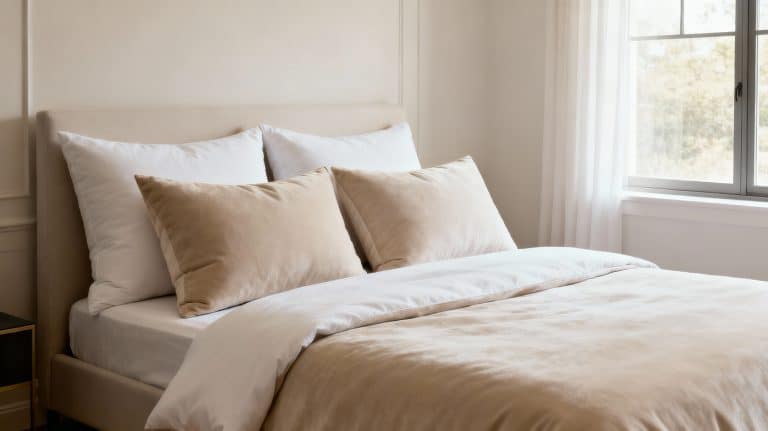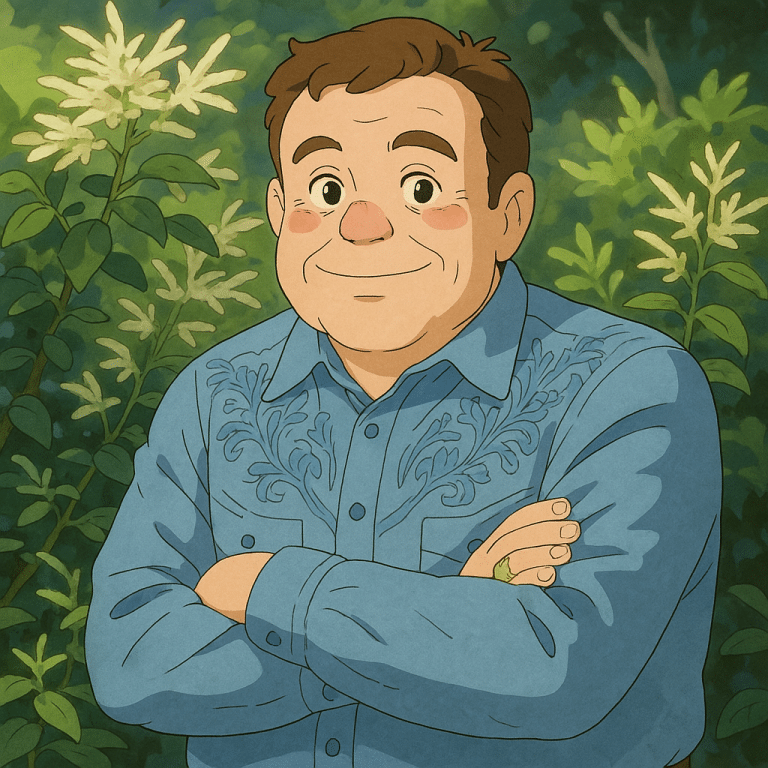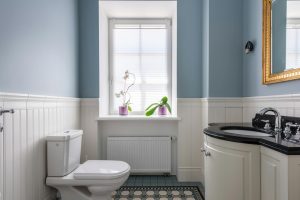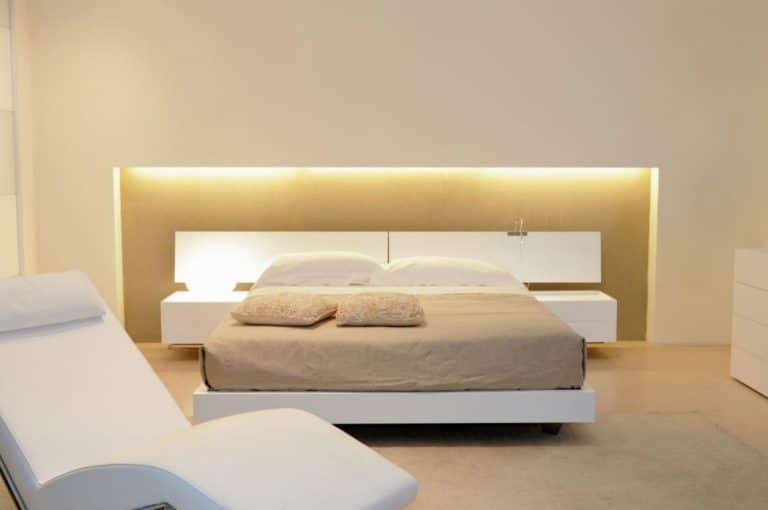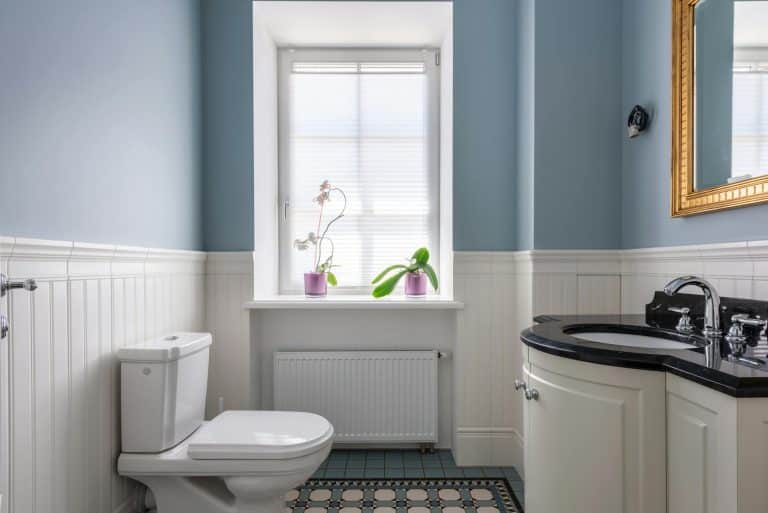Buy the wrong pillows and waste $180. King pillows on queen bed can save you from that mistake—or create it. Your 60-inch mattress meets 72 inches of pillow, and the math feels wrong. You picture overhang, crowded nightstands, a bedroom that looks off despite new bedding.
The secret: two positioning tricks turn that 12-inch difference into intentional style. You’ll test the fit in under five minutes using painter’s tape or bath towels you already own. Then see four exact arrangements that eliminate weird gaps and tilting. Wait to test, and you’ll buy blind, hoping $200 of pillows somehow work. First: mark 36 inches from your headboard center and see what happens.
Quick Fit Tests for King Pillows on a Queen
-
Tape test: A queen mattress is 60 inches wide. A king pillow is about 20 by 36 inches (that 36 is the length across the bed). Two of them side by side equal 72 inches. Lay painter’s tape across the top of your mattress to mark 60 inches, then place two 36 inch tape strips side by side. You’ll immediately see the 12 inch overage. Good sign: if you overlap the two strips by about 12 inches in the middle, they sit within the mattress width exactly what you’ll do with real pillows.
-
Towel stand in: Fold two bath towels to roughly 20×36. Place them where pillows go. Try these two arrangements: a) overlap them by about a foot in the center, or b) lean them slightly inward like a soft “V” against the headboard. You’ll see the visual effect right away. If your towels fit the way you like, your pillows will too.
Fit Math for King Pillows on a Queen
On a queen (60 inches wide), two king pillows placed edge to edge measure 72 inches across. That’s why, when you drop them on the bed without thinking, they spill past the mattress edges. The workaround is simple: overlap them in the middle by roughly 12 inches total (about a foot), or lean them at a slight inward angle so they visually live inside the mattress lines. Because pillows are soft, that overlap doesn’t look awkward. It actually reads as plush.
If you’re sleeping on them (not just styling), the overhang doesn’t change how they feel under your head. What you’re managing is the look and the way they interact with nightstands and the headboard.
Why King Pillow Sizing Looks Confusing on a Queen
Pillow sizes are listed as “20×36,” but we don’t instinctively translate which side runs across the bed. Photos online also cheat the width by angling pillows together, tucking corners behind a tall headboard, or hiding extra width with shams. And because pillows squash and curve, your eye doesn’t read the full 36 inches the way a ruler does. So if you’ve felt like the numbers and the pictures don’t match, you’re not wrong that’s the trick of soft goods.
Pros and Cons of King Pillows on a Queen
Pros, What You Gain With King Pillows
-
More surface area and stability: Each king pillow gives you extra real estate, great for side and combination sleepers or anyone who shifts around. You’re less likely to “roll off” the edge.
-
Luxe, hotel like look: The larger scale reads intentional and upscale, especially with a medium to tall headboard.
-
Fewer gaps: Overlapped or angled together, two king pillows create a continuous backdrop (no center gap) which looks clean.
-
Resourceful if you already own them: If you’re moving from a king bed to a queen, keeping your pillows makes sense just get king size cases.
Cons, Tradeoffs to Expect on a Queen
-
They don’t fit flush edge to edge: Without overlap or angle, they extend 6 inches past the mattress on each side. You’ll need to style them.
-
Pillowcases: You’ll need king pillowcases (queen cases are 6 inches too short). King cases can be pricier and color options may be fewer in store.
-
Bed making is a touch fussier: Bigger pillows mean a bit more fluffing and positioning each morning.
-
Partner dynamics: Two king pillows with no gap can place heads closer together. If you like space between, you may prefer queen or standard pillows.
-
Scale issues with low headboards: On very low or no headboard beds, king pillows can visually overwhelm.
Styling Setups That Actually Work on a Queen
If your goal is a plush look, overlap the two king pillows by about a foot where they meet, then fluff them upward to kiss the headboard. This keeps edges inside the mattress and gives that continuous, cushy line you see in styled rooms.
Have a medium or tall headboard? A slight inward angle works beautifully for arranging pillows on a queen. Think of a gentle “V” where the top inside corners meet. This is how designers “hide” width and create a soft, tailored look.
Prefer a layered, boutique vibe? Try two king pillows in cases, then add two 26 inch Euro shams in front, or swap the Euros for one long lumbar (about 12×36 or 14×48) and consider the queen throw blanket size. The long lumbar cleans up the line and keeps bed making simple.
If you mostly care about sleeping comfort, you can also use king pillows in plain cases and skip the layers. Overlap them slightly so they don’t crowd your nightstands, and you’re set.
King Pillows on a Queen, Practical Decision Guide
Pillowcases, Use the Right Size and Keep a Spare
Don’t force king pillows into queen cases there’s a 6 inch length gap that will bunch fabric and look messy. Buy king cases. If your store selection is thin, go neutral (white/cream/gray) and let your duvet or shams carry the color. Keep one spare set on hand for laundry day or surprise guests.
Bed Making and Daily Use, Faster Morning Tidy
Expect a hair more fuss bigger pillows take a few extra seconds to straighten. A quick trick: set the overlap first, then compress from the outer edges toward the center to get a neat, symmetrical line. You’ll know your setup is working when the pillows sit within the mattress edges and you’re not constantly pushing them away from your nightstands.
Sleep Style and Partners, Who Benefits Most
Side and combination sleepers tend to love the larger landing zone. Stomach sleepers usually don’t gain much from the added width. Loft and softness matter more for them. For couples who like some space between heads, queen or standard pillows (with a small gap in the middle) often feel better. After a few nights, if you’re not nudging pillows apart or feeling crowded, you picked the right size.
Budget Sense, When to Buy vs Reuse
If you already own king pillows, use them no reason to buy new. If you’re starting from scratch and you like the luxe look but want fewer variables, consider queen pillows with two Euro shams behind them. It delivers scale without the overlap step. If you’re buying king, shop sales for cases king sizes often have fewer in store options, but online fills the gaps.
Bottom line: King pillows on a queen bed can absolutely look and feel great. They will not fit edge to edge without overhang but with a simple overlap or slight inward angle, you get a plush, continuous backdrop and generous sleeping surface. If you value the luxe look, read in bed, or already own king pillows, go for it. If you want crisp edges, fast bed making, or more space between heads, stick with queen or standard. Either way, you’ve got a clear path and you’ll know within minutes of trying the tests above which camp you’re in.


